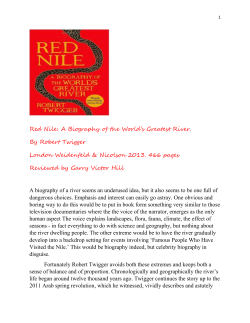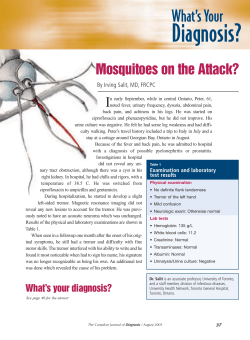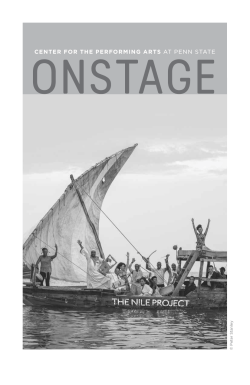
Unit 2 The Gift of the Nile
Unit 2 The Gift of the Nile Aims: To consider why Ancient Egyptian civilisation grew up on the River Nile Curriculum Links: Geography, Literacy, History Activities: Key Question Locate features on a map of Egypt Make a time line showing Ancient Egypt in the span of history Retell/write an Egyptian Myth Resources: World map, globe, school atlas Teacher Notes The River Nile, at 6695 km (sources vary), is the longest river in the world. Egypt is often referred to as the Gift of the Nile. Indeed, it is hard to imagine Egypt existing at all without the great river. Heavy rains and melting snow in the mountains of Ethiopia feed the tributaries which form the White Nile and the Blue Nile, before joining to become the great river. The torrent pours into Egypt causing the Nile to overspill its banks. When the waters eventually recede they leave behind a rich black soil which the Ancient Egyptians referred to as the Black Land (fertile soil). A Nilometer was scratched on walls, posts or buildings near to the river bank to record the level of the flood. This gave great power to the priests who could fairly accurately predict plenty or famine each year. A sort of wooden crane, called a shaduf collected water from the river for the farmer’s crops. The Nile provided fish which are shown in many tomb paintings caught in large nets. Birds in search of fish were caught by throwing sticks and then killed for the table. Mud, a vital building material, was collected at the river’s edge and shaped in rectangular, wooden moulds, then left to dry in the hot sun. The reeds that grew along the river’s edge were cut to make a kind of paper called papyrus. The same reeds were tied in bundles to make boats. To sail your boat downstream towards the sea you lowered your sail and let the current take you. To travel upstream you raised your sail to capture the power of the wind. 13 Activity 1 Key Question Curriculum Link: Geography Objective: To understand why the Ancient Egyptian civilisation grew up on the banks of the River Nile This activity relates directly to geography programmes of study on rivers and settlements. Begin by asking children why they think early settlements often grew up by rivers. Explore a map of your locality, or a map of Britain. Find how many major towns and cities are situated on a river. In groups ask children to think of as many reasons as they can for living by a river, e.g. food, transportation etc. Read the Key Question on page 17 noting how reliant the Egyptians were for food, water and resources on the river itself. Use the Think about questions to talk or write about the passage. Now ask the children to write their own version of the passage explaining the importance of the river to early settlements in Egypt. Provide the symbol pictures (page 20) as memory prompts. Children could cut out (or draw) the pictures and stick them on a page, writing a sentence or two beside each picture. Activity 2 Map of Egypt Curriculum Link: Geography Objective: To be able to locate key places on a map of Egypt Resources: Globe, atlas or Internet Use the Internet, a globe or a good school atlas to show children where Egypt is located. Point out significant features such as neighbouring countries, the Mediterranean, the Red Sea and the River Nile. Point out the proximity of the world’s largest desert, the Sahara. Provide children with a copy of the blank map on page 21. Using a good school atlas, ask them to label and colour the map. Note: Children often take the name ‘Red’ Sea literally when colouring. 14 Activity 3 Time line Curriculum Link: History Objective: To be able to place events and periods on a time line This time line, spanning more than 6,000 years, aims to give children some sense that: i) The Ancient Egyptian civilisation lasted for an enormous span of time ii) The Ancient Egyptian civilisation began a very long time ago. A good way to introduce this topic is to prepare a long strip of paper or a string to represent the span of history from the first Egyptian settlers, through to the present day. By unfolding this around the classroom or playground you can provide a glimpse, perhaps, of the huge span of time involved. To begin completing the time line (page 24), remind children of the terms BC and AD, placing the Birth of Jesus first. Explain also the meaning of circa in the footnote at the bottom page 23. Although there is evidence of the first settlers on the banks of the Nile as early as 6000 BC, a nominal starting point for the Ancient Egyptian civilisation might be taken as Menes, the first king of a unified Egypt. Refer to Internet sources for a more detailed picture. Demonstrate how to locate times on the time line, making approximations where necessary. Some dates and periods have been approximated to simplify this task (see note below). Use colour to block in the span of the Old and New Kingdoms. Add illustrations for interest. Note: Dates have been approximated in some cases to simplify this activity for school children. Search the Internet or refer to other sources for a more detailed picture, though sources vary and the history of Ancient Egypt is a complex web of overlapping dynasties and kingdoms. Activity 4 The Story of Osiris Curriculum Link: Literacy Objective: To write a story from Ancient Egypt in the style of a myth This activity links well to literacy programmes on myths, legends and traditional stories. You might begin by asking children what they know about myths already (traditional story, not necessarily true-life etc.). Explain that a myth often explains something about beliefs in ancient times, for example ‘how the world was made’. Read the story on page 25 together. Use the Think about question to explore what the story may mean. The Nile is obviously a key feature of this narrative but also the story has close links with beliefs about the afterlife and mummification (see also Unit 8, pages 92-104). Now re-read or, if you can, tell the story. Explain that, long ago, such stories were told rather than read and therefore needed phrases 15 which were easily remembered. Ask the children to join in; especially in the stylistic devices, e.g. he was ugly on the inside and ugly on the outside. Ask the children to find examples of sentences and phrases which belong to a traditional story telling style, e.g. She searched for many days or And so it was. Now children can write their own version of the story using the sorting activity on page 26 as a starting point. Add a decorated border or illustrate using the picture on page 26. 16 Key Question: Why is Egypt called ‘The Gift of the Nile’? Why did the Ancient Egyptian civilisation begin on the banks of the River Nile? Look at a map of your own region. Why do you think that major towns and cities are often situated near a river? Make a list of all the reasons you can think of for settling near a river. It is sometimes said that Egypt is the Gift of the Nile. But what does this mean? No one can survive without water, but there are many more reasons why a river brings life to those who live on its banks. This is shown no more clearly anywhere in the world than on the banks of the River Nile. The River Nile, at over 6,695 km, is the longest river in the world. Heavy rains in the mountains of Ethiopia feed the great river, causing the Nile to overspill its banks, leaving behind a rich black soil. A Nilometer (marked on nearby walls) recorded the level of the flood each year. A good flood meant food for the winter, but a poor flood meant famine and starvation. A sort of wooden crane, called a shaduf collected water from the river for the farmer’s crops. The Nile provided fish, caught in large nets, while birds were knocked from the air with sticks and killed for their meat. The mud left on the river bank provided a good building material. Collected into a rectangular, wooden mould, the mud could be shaped into bricks and left to dry in the hot sun. The reeds that grew along the river’s edge were cut to make a kind of paper called papyrus. The same reeds could be tied in bundles for boat building. To sail your boat downstream towards the sea you lowered your sail and let the current take you. To travel upstream you raised your sail to capture the power of the wind. 17 Think about: 1. How long is the River Nile? 2. Where does the river begin? 3. What happens after the flood water dies away? 4. What was a Nilometer? 5. Why was it important to measure the level of the flood? 6. Name two uses for the reeds that grew at the water’s edge. 7. Describe how you could travel both ways on the River Nile. 8. What would you use to catch fish in Ancient Egypt? 9. What other creatures might come down to the river? Why? 10. Large birds were also killed to eat. Why do you think the birds came down to the river? 19 The Gift of the Nile Use these pictures to help you write about The Gift of the Nile. Cut them out and stick them in your book, or draw your own. Write sentences to explain each picture. 20 Map of Egypt Here is a map of Egypt. Use an atlas to help you label the following on your map: EGYPT SAUDI ARABIA River Nile Mediterranean Sea Red Sea Cairo Khartoum Aswan Colour Key: Egypt = red Land = yellow Water = blue 21
© Copyright 2025





















